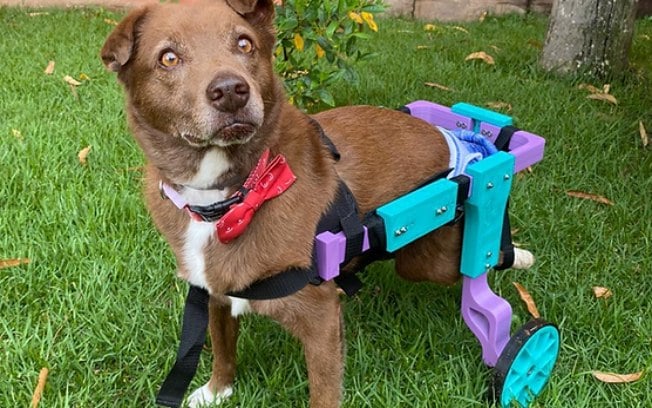Finding a home for abandoned or abused animals is a difficult mission taken on by protectors around the world, and everything becomes even more complicated when that animal goes through some specific condition, such as being elderly or with a physical disability.
Seeking to bring greater visibility to these pets, psychologist Sophia Porto Kalaf created the Cãodeirante Project, inspired by the story of her own pet, the brown dog, adopted in 2016.
Marrom lived on the street until he was two years old, when he was run over and taken to a shelter, staying there for another three years, until he was finally found and adopted by Sophia who, at the time, was a volunteer in the animal cause and helped the shelter get new adopters.
“I decided to do an adoption campaign for animals that were less likely to have [adopters] interested,” Sophia tells Canal do Pet. She took Brown to her house, with the goal of improving the pet’s health, so that he would have a better chance of finding a home.
As she lived together, Sophia began to notice a series of particularities in the care of a wheelchair dog, — until then she had not received any kind of information or guidance.
“The lack of information about these pets and the scarcity of people interested in the lesser-seen animals [disabled and elderly] inspired the creation of the project, which aims to give visibility and encourage the adoption of pets with disabilities,” she says.
In addition to being a mascot, the mixed-breed dog was the symbol and CEO of the Institute, which is now also recognized as its legacy. Brown died in September 2023 at the age of 12 from myasthenia, a rare neuromuscular disease.
One of the biggest difficulties in taking care of an animal with a disability is in the health care routine, since these pets may need, for example, help to relieve themselves.
Currently, the project has the support of specialized professionals. “We have two volunteer veterinarians who help us,” says Suiane Torres, a volunteer at Cãodeirante and organizer of the National Meeting of Special Pets (ENPE).
Like Sophia, Suiane is also a pet owner with disabilities. “We had to learn the ropes, so we were the ones who taught the adopters. We advise on how to empty the bladder, bowel […] We have videos about it on social media and on the website,” he says.
She continues: “Many veterinarians, including our rescuers, say ‘[the pet] knows how to pee on its own’, when, in fact, [the animals] don’t and the lack of emptying [the bladder] in these cases, even with this urinary incontinence, generates an infection. It is important to make this clarification, to have this correct management to avoid several problems.”
The work of the Cãodeirante Institute
Today the Institute no longer carries out rescues directly, due to financial issues such as keeping a high number of animals in the shelter and also difficulties in paying for the temporary homes — since these animals need more attention than a pet with full physical condition.
“We stopped doing rescues, because we have a very big difficulty with the temporary home. It’s very complicated,” says Suiane, noting that the project also operates in adoption fairs — its own and collective — in addition to promoting third-party and online events.
“We promote meetings for pets with disabilities and, in addition, we receive many requests from people interested in adopting a pet with disabilities. We do this work of understanding the adopter’s profile and showing him the pet’s disability, as well as the care necessary for its routine. The main objective of our work today is to bring information.”
How to help the project Because
it
no longer keeps animals in its care, the Cãodeirante Institute does not have a continuous fundraiser, but only for holding events or indicating fixed donors to NGOs and shelters for animals.
“The first and most effective way to help us is to adopt or share our [social] networks for adoption, go to trade shows, and buy our products,” Sophia explains.
The products and amounts collected by donation are directed to the realization of adoption fairs and animal treatments, such as physiotherapy, surgery, among other needs. There is also a page with accountability documents on the site.
Follow the Pet Channel also on social media: Instagram, X (Twitter) and Facebook.
